Fear + desire in the Futures group show, with Cory Arcangel, Shimabuku + more at CAC, Apr 14 – May 28
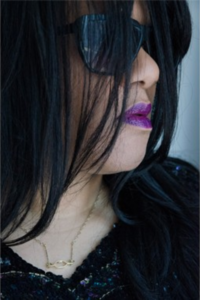


Cory Arcangel will present solo show, currentmood at London’s Lisson Gallery, running May 19 to July 2.
The New York-based artist will install images, all printed the same scale of scans of Ibiza flyers, tracksuits and magazines, default Photoshop image effects, commercial and cell phone photography and low-res screen captures that would, if cropping up on a social media feed, be hashtag-ged with the words ‘currentmood’; a way of illustrating your specific emotional state via an image that is not specific or related to you and your life at all.
While the show runs, Arcangel will also share a series of ads across his social media accounts, promoting the exhibition and in doing so, by using the phrase #currentmood, will continue the work online.
Committed to a democratic practice of open source web culture, the artist is known for thoughts like these:
Arcangel is attentive to collective memories, celebrating their outmoded aesthetics while interrogating their cultural moment. “I’m not taking sides with almost anything… “For me, to see how these things change is my interest” ¯\_(ツ)_/¯
See the Lisson Gallery website for more details.**
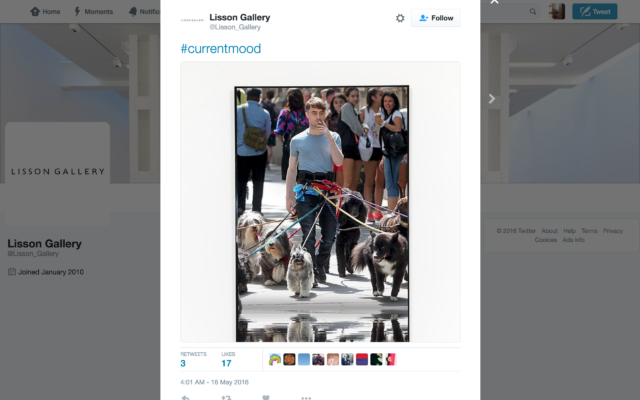
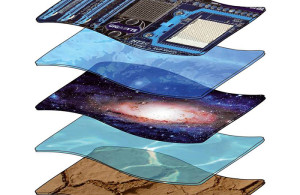
Parc Saint Léger brings a new exhibition by the name of Deep Screen and running at the Pougues-les-Eaux, France art space from March 13 through March 24.
Borrowing from Paris’s National Museum of Arts and Popular Traditions (MNATP), Deep Screen explores the screens that inhabit our modern lives, overrun with computers, smartphones, and tablets that filter our reality and predominate our perception and absorption of contemporary art. The press release reads: “Far from being an apologist virtual tours , the immersive Deep Screen invites you to an experience of exposure to any materiality.”
The exhibition features thirteen different artists and artist groups, including Rachel de Joode, who we’ve written about for last year’s joint exhibition with Kate Steciw, as well as Cory Arcangel, Renaud Jerez, and Owen Piper.
See the exhibition FB page (in French) for details. **

Seeing and talking about the Barnie Page-curated Genuine Articles show is one thing. Trying to make sense of the graphical flowering of links, images, reference points and ‘spaces’ in its infinity mirror of metanarratives is another. Right now, I have two browser windows open with about 10 tabs each (not including pop-ups) featuring information that is all somehow related to the subject at hand. The subject at hand being an exhibition of art documentation about an exhibition of art documentation that also features art documentation of exhibitions about art documentation, if you follow.
Running at London’s Jupiter Woods from October 2 to 25, Genuine Articles explores the aura of the artist and/or the artwork via its boundless reproductions, recontextualisations and reappropriations made possible by the internet. Spreading itself across platforms, namely the ‘real life’ location of the exhibition space and the online documentation thereof on a specially built website, the show draws from myriad artworks where their original, or ‘genuine’ sources have become so abstracted by the fracturing logic of the network that any notion of authorship becomes, as the press release states, “questionable and difficult to place, and at times of no importance”.
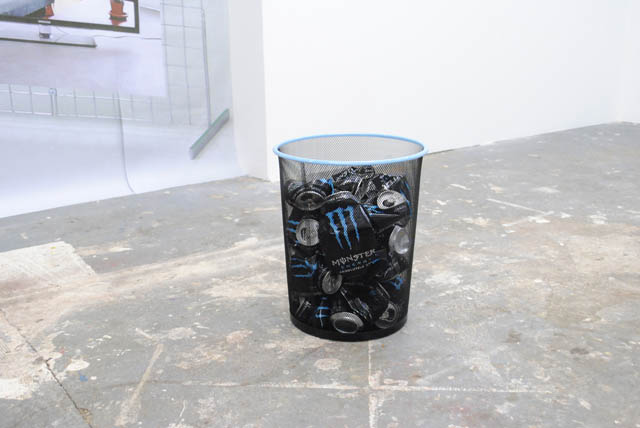
Hence, Barnie Page’s ‘this ain’t soda pop, dude!‘ (2014) sculpture at the centre of the Jupiter Woods space, where a black and blue mesh wastepaper basket filled with empty black and blue Monster Energy Absolutely Zero cans respond to Cory Arcangel‘s instructions to Ryan Gander on recreating one of his own sculptures called ‘To Protect Space’ (2011). The Arcangel original featured limited edition Tron Coke cans which a cashpoor Gander reconfigured into ‘Enjoy Responsibly’ (2012) to save on shipping for his Ampersand installation in Paris. That “cover version” featured a bin that colour-matched the Bacardi Superior and Zero Calorie Cola of his own chosen beverage.
Hanging on the wall to the right of Page’s trashcan (if you’re facing the wall of Mona Lisa postcards, souvenirs and accessories) an A4 print-out, ‘Yin Yang Rock’, is credited to “various artists” and lacks a date of production. That’s because if you traced the original scultpture (now lost) back to its source (as Page did through Google’s “search by image function”), through the NO PERMISSION/ABSOLUTE HEARTBREAK exhibition – where Andreas Banderas reproduced it and Ben Vickers commissioned it – and Carmen Mueck who sculpted it before, you’d find that ‘Ying Yang Rock’ was in fact a meteorite that fell to earth in 1860. The universe itself is it’s author.
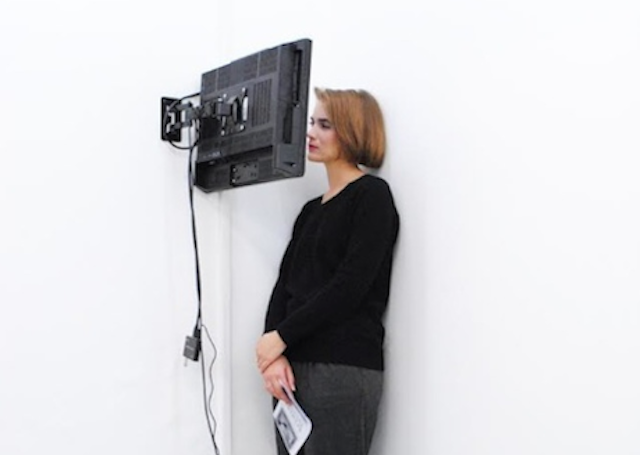
On the opposite wall from the fallen rock facsimile is a wall-length print of an image of Joey Villemont and Camille le Houzec‘s Screenplay exhibition held at Glasgow’s SWG3 Gallery. Giving the illusion of a three-dimenional extension to the Jupiter Woods space, it’s a flattened photo of a physical exhibition that was itself a representation of digitised art documentation – including that of Simon Denny, Philip Timischl and Anne de Vries among others – originally (or is it secondarily?) presented on Villemont and Houzec’s online exhibition space, itsourplayground.com.
Then there’s ‘Emily’s Video Reactions‘ by Eva and Franco Mattes screening reactions to the “worst video ever” from a TV in the corner that’s facing a wall. The source of its viewer’s distress was a film found in the deep web and promptly destroyed, so “the second hand experiences are the only proof of its existence” on YouTube. With that its the second hand experience of said second hand experience that an IRL audience becomes witness to at Jupiter Woods, as only one person at a time can view the video in the tight spot between the white wall and the screen. That’s where you consider Genuine Articles and each object, or each image of an object, or each image of an image of an image of an object becoming merely a reflection of a particular historical, cultural, physical, even emotional context. Because at any given time an artwork, whether ‘genuine’ or not, is less a reflection of its author than the position of the person that’s looking at it. **
Exhibition photos, top right.
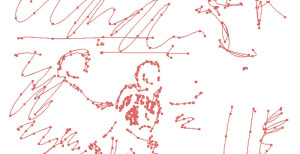
Société and Lisson Gallery present the German premiere of Cory Arcangel‘s ‘Dances For The Electric Piano‘ at the Berliner Philharmonie, on May 2.
The composition will be performed solo by organist Hampus Lindwall on the Korg M1 piano famous for the classic Rave and Trance breakdowns of the 80s and 2000s.
It follows the opening of Arcangel’s All the Small Things exhibition, running in Denmark to June 22, and features conservatoire-educated musician, Lindwall, as a student of the late-Rolande Falcinelli in Paris and noted for his collaborations with other visual artists including John Duncan and aalliicceelleessccaannnnee&ssoonniiaaddeerrzzyyppoollsskkii.
See the Cory Arcangel website for details. **
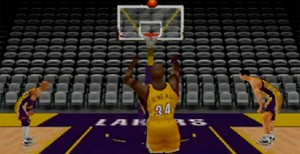
Cory Arcangel is presenting solo exhibition All the Small Things at Denmark’s Herning Museum of Contemporary Art (HEART), opening March 21 and running to June 22.
Serving as a survey of sorts, the exhibition title, presumably taken from the 1996 Blink-182 song of the same name, draws on the fact that at 35 years old, Arcangel is already considered a pioneer in the field of new media art. This will Arcangel’s first show of new work in three years, also featuring some older seminal pieces and launching with a performance of ‘Dances For The Electric Piano‘.
Since his early days of hacking gaming consoles, new media platforms and the consumption of them have changed drastically, all of which Arcangel approaches through the eyes of an artist begun in the swell of a once free, since then, not so much network.
See the HEART website for details. **

“Does that say Beyonce?” asks a dude in a black Frieze t-shirt, before sidling up to Jonathan Horowitz’s ‘Beyonce’ –a full length, blue reflective mirror with the globally recognisable pop brand written below –to have his picture taken. This is the beginning of an exhausting trek through the Frieze London labyrinth, where stall after stall presents works catering to infinite sensibilities and, importantly, bank balances. Most are up for sale, some “really not sellable” as one bright passer by points out, but no less significant. ‘You are what you buy’, as they say, and in a social strata that can be reduced to the online check boxes of the Frieze London search terms for “Artworks” (from Under £10k to “Unspecified”) this kid isn’t paying Horowitz’s Pia/Weiss gallery anything.
So, in search of work worth seeing that isn’t a part of the Frieze week fringe events (read more here), the aim is to wade through artworks trying to out loud each other by sheer mass, or size of the name behind it. “Art is just like an advertisement of itself already” as Katja Novitskova pointed out in an aqnb interview earlier this year, and here, it’s nowhere more apparent. But what’s more striking than the obvious and highly problematic economics behind art production, this rambling knot of works from around the world (but centred on its traditional capitals) is how reflective they are of a particular context.
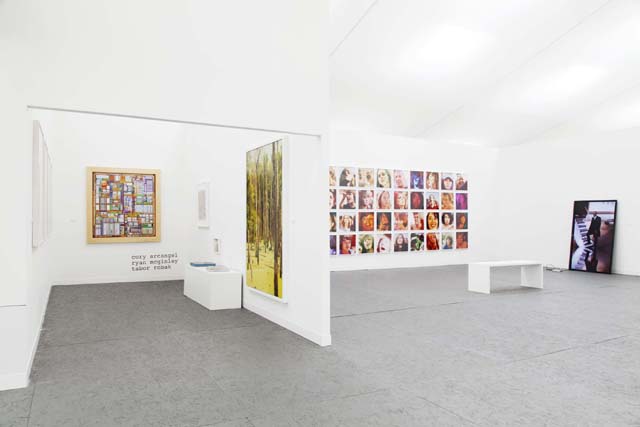
There’s the moneyed investment capital one, for example. Eye-rollingly obvious, maybe, but that doesn’t make the Picasso’s, Magritte’s, Ottoman carpets and Medieval church plunder on sale at the ‘luxury art’ sector of Frieze Masters any easier to digest. Here, copies of the Financial Times are liberally handed out to patrons (not me) and tribal art can be ogled accompanied by complimentary Turkish treats, while I’m reminded of CANAN’s ‘Turkish Delight I’, a reanimated Orientalist nude looking up from a translation of Judith Butler’s Gender Trouble, across from Hüseyin Bahri Alptekin’s ‘Elite’ in Frieze London’s Rampa space. The talks at Frieze Masters are of a particular ilk too, featuring painters and photographers concerned with the specifics of their practice and presented by representatives of major art institutions like the V&A, National Gallery and Kunsthistorisches Museum Vienna. There’s Nil Yalter’s ‘Temporary Dwellings’, images of displaced migrant communities to be bought and displayed on walls far removed from their reality, while discussion on ‘Sexuality, Politics and Protest’ or issues of “Black British identity” with John Akomfrah are relegated to Frieze London. Annie Leibovitz’s ‘Isabella Rossellini and David Lynch’ is about the closest Masters comes to the post-Warholian pop cultural obsession of emerging artists scattering the Frieze London tent, a collective fascination with the Kanyes, Clintons and #NSFWs of recent, to extremely recent history pointing to the total infiltration of mass media, post-2000.
The boy with the bowl haircut who so adored Horowitz’ ‘Beyonce’ turns out to be a part of the performance of James Lee Byars’ ‘Four in a Dress’, along with three other heads poking through a drape of black cloth. An awkward interaction ensues when a dashing young man with blue blazer, flashy watch and winning smile engages him with, “so you’ve had your haircut but the rest…?” That feeling of unease continues with a monolithic print from the Bernadette Corporation at Greene Nafatali, obstructing entry into the Wilkinson space is Ilja Karilampi’s ‘VICKI LEEKX’ banner –last seen on M.I.A.’s 2010 mixtape of the same name –and there’s also KyungA Ham’s dazzling embroidery ‘SMS Series / Greedy is good’. David Lieske’s gaudy works on paper, ‘Style and Subversion (I-V)’, illustrates the monstrous art-fashion hybridisation, the tension between aesthetic and concept, dogging emerging art today –where everything is art, everything is commodity and vice versa, a-la the now infamous ‘Jay-Z gallery’ (aka Pace) nearby.
Yet, all is not lost and there are still ways of evasion, at least for now. Ephemeral art and sound is as always less present, its very nature as immaterial an impossible sell. Although there are efforts to solve said ‘problem’, a brilliantly integrated wall-mounted video installation by Diana Thater, ‘Day for Night Four’, a case in point, while Sturtevant’s ‘Trilogy of Trangression’, featuring a three channel video of a blow up doll’s back side being penetrated by Rosary beads, a Coke can, a tube of toothpaste, in film resolution akin to 90s pornos, states “THIS VIDEO IS NOT FOR SALE”. The Tate just bought it.
The more interesting works offer an experience rather than an object to contain and be packaged. There’s Emdash Award winner Pilvi Takala’s video and performance work, ‘Drive with Care’, screened in a space resembling a lounge room, as the Finnish artist describes how a role as advisor intrudes on her life, from texts outside office hours, to organising a burial for a dead goldfish. Ian Cheng’s ‘Entropy Wrangler Cloud (Chang & Eng)’ at Miami’s Formalist Sidewalk Poetry Club presents augmented material and spatial reality through 3D goggles, while another Karilampi, ‘October’s Very Own’, explores pop cultural memory by entombing it in a single space, across timelines. A documentary-like video of Jimi Hendrix’s infamous arrest in Sweden in 1968, ‘Hendrix Incident’, screens on the wall of the imaginary hotel room the performer destroyed in Gothenburg. Resembling an early 90s underground nightclub, an onlooker familiar with the era explains the plywood chairs as iconic before pointing to a bench decorated with shards of glass, “this is where someone really inspiring would play”. Meanwhile, Karilampi’s ‘realness mixed emotions’ inkjet print, an iPhone interface referencing Zurich nightclub House of Mixed Emotions, hangs above the scene as ominously as the installation title’s reference to RnB heavyweight Drake’s ‘OVO’ label.

The person invigilating the aforementioned Sandy Brown space strikes an oddly comforting pose in the face of the pink champagne and plush port-a-potties of the Frieze London venue-at-large. His Nike sneakers a gesture to that familiar self-reflexive irony that Karilampi’s work plays on; a dejected hedonism that appears to pervade much of the more interesting work on show. That’s excepting, perhaps, the more constructive site-specific work of Angelo Plessas in the Frieze Projects space, where, along with Takala’s youth-centred ‘The Committee’ commission, engages primary school children in his Temple of Play. Bridging the gap between Internet and IRL, a spiralling Styrofoam construction and interactive touch screen are the setting for posed snaps of Plessas with a group of Year 5s crafting their own emoticon masks from cardboard and stickers.
Beyond broadening the art interaction age bracket, breaching the world beyond the West, however disproportionately, is the presence of Bidoun magazine, wedged in the corner among the Kaleidoscope and Harper’s Bazaar Art China magazines at the publication stands, while the Gulf, a region with so much of a global stake but so little outside understanding of it, is best opened up through Sophia Al Maria’s ‘Between Distant Bodies’ –unmarked save for her name, and featuring two stacked cuboglass TVs screening video of unsettlingly grafted imagery exploring physics and communication. Veteran Iranian artist Monir Shahroudy’s Muqarna-inspired cut glass sculpture ‘Seven’ also features at The Third Line stall, while Grey Noise, a gallery from the same Al Quoz industrial district of Dubai, is easily overlooked for its smaller nuanced works of Mehreen Murtaza‘s framed multimedia collages combining Sufi imagery and sci-fi logic, ‘Transmissions from a missing satellite’. In the same way, the chilling implications of a light-box colour transparency of swamp vegetation by UK film maker and artist Steve McQueen could be missed if not for its title, ‘Lynching Tree’, a didactic component that necessitates reading but many don’t.
Across from The Third Line is one of the most impressive surprises of the fair, a video by Nelisiwe Xaba & Mocke J Van Vueren. Here, duplicate Xabas emulate the human chain of the Venda Domba dance in South Africa’s Limpopo province, with reference to virginity testing and the omnipresent male gaze, care of its title ‘Uncles & Angels’, it’s imagery made all the more unsettling by the 3D glasses and uncanny-sounding score by João Orecchia.
The industrial backdrop to all this production and consumption is best represented by Thomas Struth’s ‘Ulsan 1 and 2’, colossal wall-width photographs of high rise apartment blocks, a commercial district and industrial smoke in the background, while Tabor Robak’s four channel video projection of ‘Screen Peeking’ illustrates its outcomes through CGI. The films’ lenses slowly pan across the nauseatingly cheery and abundant products in an otherwise empty supermarket, a video game banquet and a showcase of grotesque conceptual dishes, offset by a screening of organisms at a micro-level. In the same team (gallery inc.) space, probably the most hip of the fair, the new establishment art of Cory Arcangel’s ‘Diddy/Lakes’ –the slightly pixelated pop persona stepping off a light plane into a shimmering, seemingly endless puddle –Ryan McGinley’s ‘Me and My Friends’ photos and Robak’s fetishised rendering of a 90s processor in ‘1998 Pentium II Xeon’ are probably the most knowingly commodifiable artworks. The implicit critique is indistinguishable from its own complicity and as literally internalised as Xu Zhen’s MadeIn Company art production business venture. The Chinese artist’s ‘Unification is a reductive process rather than a process of gain, in which loyal believers never feel complete or secure’ acrylic on canvas work, that resembles a PaintShop job, easily draws parallels with the problems of globalisation and late-capitalist hegemony, buttressed by a digital culture that these artists represent.
All this matters because, as a major win for the online-and-in-the-bedroom artist, Petra Cortright’s Frieze Film commission, ‘Bridal Shower’, not only produced a fair highlight but potentially opened the floor to similarly DIY artists. Extending on her famous selfies, the dreamy single shot video features self-love to a soundtrack by Nightcoregirl, while one wonders, as experience becomes commodity, so too must the ephemeral arts and the artists that come with it. **